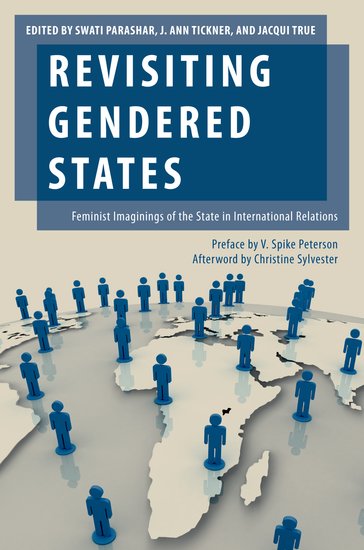The second post in our short series on the edited volume Revisiting Gendered States: Feminist Imaginings of the State in International Relations (Oxford, 2018) – the full series may be viewed here. In this post, Christine Agius revisits here contribution to the volume. Christine is Senior Lecturer in Politics and International Relations at Swinburne University and the author of a number of pieces on sovereignty, identity, foreign policy and security, most recently (with Emil Edenborg), ‘Gendered Bordering Practices in Swedish and Russian Foreign and Security Policy’, published in Political Geography.
Like some of the most important questions of the day – will there ever be a decent Terminator film beyond T3, and is it still ok to love Broad City after their Hillary love-in – the question of who or what the state is has perhaps never been as important as it is in these troubling times. As authoritarian and right-wing governments produce electoral wins, and initiate policies that seek to assert the power of the state in the name of ‘the people’, the effects and affects are becoming more and more visible across a range of levels and registers. So much has already been written about recent authoritarian politics, including in this forum (see here, here and here). As I began to write this blogpost, the US border with Mexico militarised with the visible presence of troops, tanks and weaponry in preparation for the arrival of the ‘caravan’ of mostly women and children from Honduras. Austria had rejected a UN migration pact in order to ‘defend its national sovereignty’. And Jair Bolsonaro, Brazil’s newly-elected president, has projected the view that international climate action is a threat to Brazil’s national sovereignty. Public discourse and debate has been deemed to have become uncivil, individuals emboldened to ‘say what they think’ or act on impulses that until recently might have been kept in check, whether it be policing non-white citizens or ‘going in’, to deal with ‘invaders’ as the Pittsburgh shooter who killed 11 people at the Tree of Life synagogue recently did. The visibility of the alt-right in western democracies even conforms to specific aesthetics, from the alt-right art of ‘fashwave’ to MAGA caps and Hitler Youth haircuts.
Despite liberal anxiety about the rise of right-wing populism (or should we just call it fascism?) as a decisive and seismic moment of rupture for liberal democracy, this isn’t necessarily new. While we may be tempted to see this as a crisis point in ‘normal’ politics, some have highlighted how the very basis of liberal democracy might sow the seeds of the divisions we now see across lines of tolerance, race, gender and political economy. Here the debates are as complex as they are multifarious. Take, for instance, the rise of an overtly masculinised approach to protecting borders and defending sovereignty. This ‘strongman’ politics blatantly attempts to raise defences against imagined outside incursions – and it is easy to see the gendered dynamics that construct these efforts to reclaim and exert power, order and hierarchical relations. We see it in ‘America First’, and ‘take back control’, as well as replicant iterations elsewhere. It also provokes a sort of counter-strongman response. I’m thinking here about Arnold Schwarzenegger (as I often, inexplicably, do) taunting Trump over Putin, support for white supremacists or climate change denial. While Arnie gets a lot of likes for this, he’s still married to a conservative idea of what the state is, what statecraft should look like, and how strength should be used. This is part of the problem. Dig a bit deeper, and the very order we’re claiming to defend relies on ideas of strength, autonomy, rationality. This is highly gendered, not simply in the way ideas of strength and weakness are invoked, but in the sort of solutions and responses that are offered to counter such positions.
So instead of rupture, I’d rather talk about continuities. I was reminded by Debbie Lisle, at her recent workshop for Roland Bleiker’s Visual Politics seminar series at UQ, of the idea of intensification. Debbie used this a long time ago in response to the crisis of 9/11 – rather than see 9/11 as a rupture, it was an intensification of already existing and ongoing processes. It’s been a useful device for teaching my critical terrorism studies class, and I’ve referred to it ever since. At her UQ seminar, intensification again emerged in response to the migrant ‘crisis’, in this case, how ‘crisis’ invites affective modes of urgency, enabling and disabling certain actions, responses and responsibilities. Intensification has me thinking about this exact juncture between event, rupture, and crisis, which seems to constantly interject into ‘normal’ politics. There is a purpose and a danger to categorisations of rupture and crisis – such descriptors can invoke a range of different responses, placing events out of time, context and space. This has been interrogated in various ways across political economy, democracy, and security post-9-11 and in the era of Trump. So, I want to skirt away from the realm of urgency and instead look to and try and expose the continuities when apprehending how gender is threaded into the very fabric of states and the performance of statehood. And herein lies the complexity: gendered states are practised and performed in different ways, and often rework the very conditions they claim to try to change. Focussing on rupture can distract us from what is already embedded and part of the very thing we are trying to defend. So instead maybe we ought to look to the spaces in-between – the cases where we might miss the signs and connections of the ways in which gendered states operate and persist, or work in different ways.
Continue reading →
 The Disorder of Things is delighted to host a symposium on Brenna Bhandar’s new book, Colonial Lives of Property: Law, Land, and Racial Regimes of Ownership. First up is the symposium organiser, Alvina Hoffmann, a PhD student in IR at King’s College London. She is review article editor, social media officer and member of the editorial board of Millennium: Journal of International Studies. She is co-convenor of the research group Doing International Political Sociology. Her thesis investigates the annexation of Crimea, the Sami people’s struggle over land rights and the Internet users’ claims over digital spaces through the lens of rights claims practices which intersect in various institutional settings such as the UN.
The Disorder of Things is delighted to host a symposium on Brenna Bhandar’s new book, Colonial Lives of Property: Law, Land, and Racial Regimes of Ownership. First up is the symposium organiser, Alvina Hoffmann, a PhD student in IR at King’s College London. She is review article editor, social media officer and member of the editorial board of Millennium: Journal of International Studies. She is co-convenor of the research group Doing International Political Sociology. Her thesis investigates the annexation of Crimea, the Sami people’s struggle over land rights and the Internet users’ claims over digital spaces through the lens of rights claims practices which intersect in various institutional settings such as the UN.
